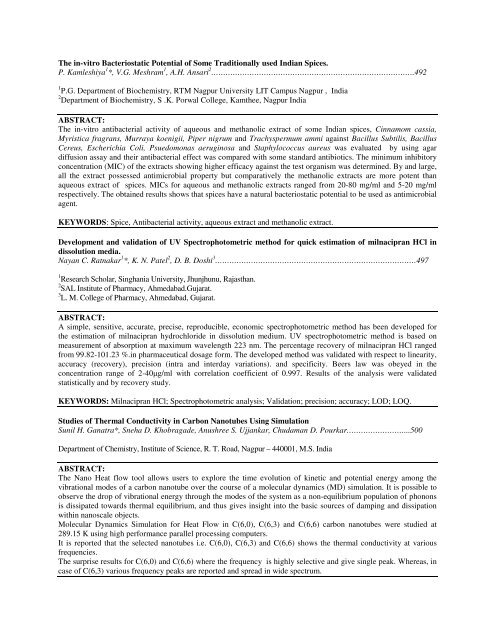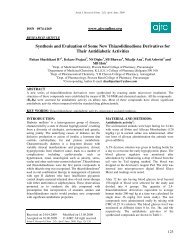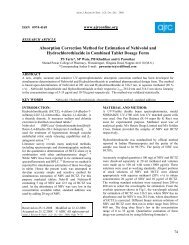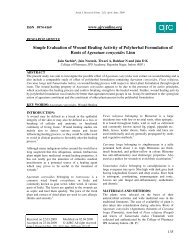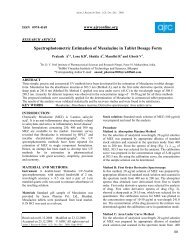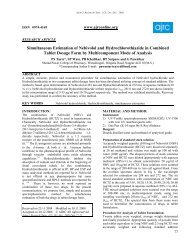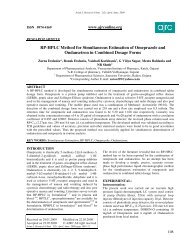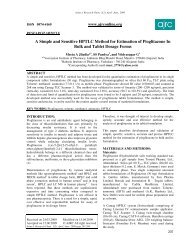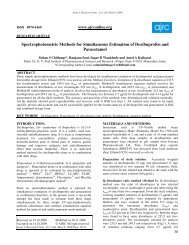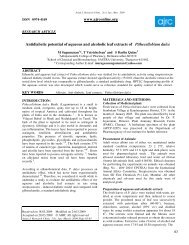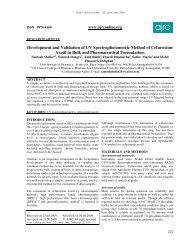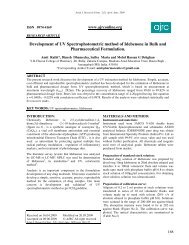Issue-4_April - Asian Journal of Research in Chemistry (AJRC)
Issue-4_April - Asian Journal of Research in Chemistry (AJRC)
Issue-4_April - Asian Journal of Research in Chemistry (AJRC)
You also want an ePaper? Increase the reach of your titles
YUMPU automatically turns print PDFs into web optimized ePapers that Google loves.
The <strong>in</strong>-vitro Bacteriostatic Potential <strong>of</strong> Some Traditionally used Indian Spices.<br />
P. Kamleshiya 1 *, V.G. Meshram 1 , A.H. Ansari 2 ………………………………………………………………………….492<br />
1 P.G. Department <strong>of</strong> Biochemistry, RTM Nagpur University LIT Campus Nagpur , India<br />
2 Department <strong>of</strong> Biochemistry, S .K. Porwal College, Kamthee, Nagpur India<br />
ABSTRACT:<br />
The <strong>in</strong>-vitro antibacterial activity <strong>of</strong> aqueous and methanolic extract <strong>of</strong> some Indian spices, C<strong>in</strong>namom cassia,<br />
Myristica fragrans, Murraya koenigii, Piper nigrum and Trachyspermum ammi aga<strong>in</strong>st Bacillus Subtilis, Bacillus<br />
Cereus, Escherichia Coli, Psuedomonas aerug<strong>in</strong>osa and Staphylococcus aureus was evaluated by us<strong>in</strong>g agar<br />
diffusion assay and their antibacterial effect was compared with some standard antibiotics. The m<strong>in</strong>imum <strong>in</strong>hibitory<br />
concentration (MIC) <strong>of</strong> the extracts show<strong>in</strong>g higher efficacy aga<strong>in</strong>st the test organism was determ<strong>in</strong>ed. By and large,<br />
all the extract possessed antimicrobial property but comparatively the methanolic extracts are more potent than<br />
aqueous extract <strong>of</strong> spices. MICs for aqueous and methanolic extracts ranged from 20-80 mg/ml and 5-20 mg/ml<br />
respectively. The obta<strong>in</strong>ed results shows that spices have a natural bacteriostatic potential to be used as antimicrobial<br />
agent.<br />
KEYWORDS: Spice, Antibacterial activity, aqueous extract and methanolic extract.<br />
Development and validation <strong>of</strong> UV Spectrophotometric method for quick estimation <strong>of</strong> milnacipran HCl <strong>in</strong><br />
dissolution media.<br />
Nayan C. Ratnakar 1 *, K. N. Patel 2 , D. B. Doshi 3 …………………………………………………………………………497<br />
1 <strong>Research</strong> Scholar, S<strong>in</strong>ghania University, Jhunjhunu, Rajasthan.<br />
2 SAL Institute <strong>of</strong> Pharmacy, Ahmedabad.Gujarat.<br />
3 L. M. College <strong>of</strong> Pharmacy, Ahmedabad, Gujarat.<br />
ABSTRACT:<br />
A simple, sensitive, accurate, precise, reproducible, economic spectrophotometric method has been developed for<br />
the estimation <strong>of</strong> milnacipran hydrochloride <strong>in</strong> dissolution medium. UV spectrophotometric method is based on<br />
measurement <strong>of</strong> absorption at maximum wavelength 223 nm. The percentage recovery <strong>of</strong> milnacipran HCl ranged<br />
from 99.82-101.23 %.<strong>in</strong> pharmaceutical dosage form. The developed method was validated with respect to l<strong>in</strong>earity,<br />
accuracy (recovery), precision (<strong>in</strong>tra and <strong>in</strong>terday variations). and specificity. Beers law was obeyed <strong>in</strong> the<br />
concentration range <strong>of</strong> 2-40g/ml with correlation coefficient <strong>of</strong> 0.997. Results <strong>of</strong> the analysis were validated<br />
statistically and by recovery study.<br />
KEYWORDS: Milnacipran HCl; Spectrophotometric analysis; Validation; precision; accuracy; LOD; LOQ.<br />
Studies <strong>of</strong> Thermal Conductivity <strong>in</strong> Carbon Nanotubes Us<strong>in</strong>g Simulation<br />
Sunil H. Ganatra*, Sneha D. Khobragade, Anushree S. Ujjankar, Chudaman D. Pourkar……………………...500<br />
Department <strong>of</strong> <strong>Chemistry</strong>, Institute <strong>of</strong> Science, R. T. Road, Nagpur – 440001, M.S. India<br />
ABSTRACT:<br />
The Nano Heat flow tool allows users to explore the time evolution <strong>of</strong> k<strong>in</strong>etic and potential energy among the<br />
vibrational modes <strong>of</strong> a carbon nanotube over the course <strong>of</strong> a molecular dynamics (MD) simulation. It is possible to<br />
observe the drop <strong>of</strong> vibrational energy through the modes <strong>of</strong> the system as a non-equilibrium population <strong>of</strong> phonons<br />
is dissipated towards thermal equilibrium, and thus gives <strong>in</strong>sight <strong>in</strong>to the basic sources <strong>of</strong> damp<strong>in</strong>g and dissipation<br />
with<strong>in</strong> nanoscale objects.<br />
Molecular Dynamics Simulation for Heat Flow <strong>in</strong> C(6,0), C(6,3) and C(6,6) carbon nanotubes were studied at<br />
289.15 K us<strong>in</strong>g high performance parallel process<strong>in</strong>g computers.<br />
It is reported that the selected nanotubes i.e. C(6,0), C(6,3) and C(6,6) shows the thermal conductivity at various<br />
frequencies.<br />
The surprise results for C(6,0) and C(6,6) where the frequency is highly selective and give s<strong>in</strong>gle peak. Whereas, <strong>in</strong><br />
case <strong>of</strong> C(6,3) various frequency peaks are reported and spread <strong>in</strong> wide spectrum.


